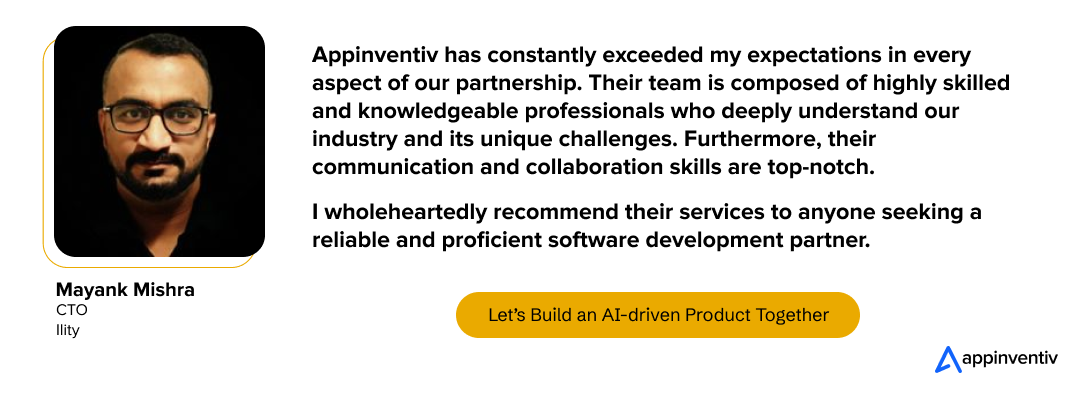- Current Market Glance: AI for Product Development
- AI Development Lifecycle: Phases of Integrating AI in Product Development
- Define Objectives
- Collect Relevant Data
- Prepare Data
- Design the AI Model
- Train the Model
- Evaluate the Model
- Deploy the Model
- Monitor and Maintain the Model
- How Does AI Work in Product Development?
- The Role of Generative AI for Product Development
- How is AI Transforming Product Development?
- How to Build an AI-Powered Product?
- Starting with Market Research
- Identifying Ideal AI Skills and Talent
- Encouraging Cross-functional Collaboration
- Cultivating AI-powered Culture
- Decoding Key Use Cases of AI in Product Development
- Use Case 1: Predictive Maintenance
- Use Case 2: Regulatory Compliance
- Use Case 3: Graphic Designing
- Use Case 4: Identifying Customer Needs
- Use Case 5: Customer Journey Mapping
- Use Case 6: SaaS Platform/Application
- Cost of AI in Product Development
- Data Collection
- Data Preprocessing
- Hardware
- Cloud Services
- Algorithm Design
- Training AI Models
- AI Frameworks
- Deployment
- Support and Maintenance
- Security
- Training
- How to Integrate AI in an Existing Product
- Ethical Challenges Encountered in Product Development Using AI
- Bias and Discrimination
- Data Privacy
- Transparency and Explainability
- Intellectual Property
- Ethical Use of AI
- Core Benefits of AI in Product Development
- Boost Productivity
- Lesser Development Costs
- Faster Time-to-market
- Higher Product Quality
- Enhanced Innovation
- Personalized User Experience
- Data-driven Decision Making
- Flexibility and Scalability
- Transform Your Product Development Workflow with Appinventiv’s Custom AI Services
- The Future of Product Development with AI and Associated Technologies
- FAQs
Leveraging AI in product development is vastly changing the manufacturing industry’s landscape. The sector is slowly but steadily adopting more advanced practices as more organizations gear up for AI product strategy. This latest innovative technology is fast becoming one of the top trends in the ever-expanding product development domain.
A Markets and Markets study reports that the artificial intelligence (AI) market is set to grow from $214.6 billion in 2024 to $1339.1 billion by 2030. The provided data insights show why this is the perfect time to harness AI tools for product development. From graphic design to AI-powered chatbots, AI for product development has huge potential!
So, let’s begin the article by finding out how you can use generative AI in product development by navigating the top AI in product development use cases, benefits, costs, and more.
Current Market Glance: AI for Product Development
90.9% of companies presently integrate artificial intelligence into their software development methods.
This proves that AI is becoming an important part of the development cycle. Using AI in product development can transform how companies conceptualize, design, and introduce their products. This covers everything from identifying market trends to creating prototypes and maximizing manufacturing efficiency.
The market for AI in product development is set to reach $20.8 billion by 2028.
This shows that AI-powered product development has limitless potential, with new tools being invented frequently. AI tools improve product quality and enhance the efficiency of the entire AI product development life cycle. Development companies can operate better with AI’s assistance by making better decisions and generating fresh concepts.
AI Development Lifecycle: Phases of Integrating AI in Product Development
Integrating AI in product development involves meticulous planning and execution, which go through several critical stages of designing and developing the intelligent AI models. Let’s explore the AI development lifecycle step by step:
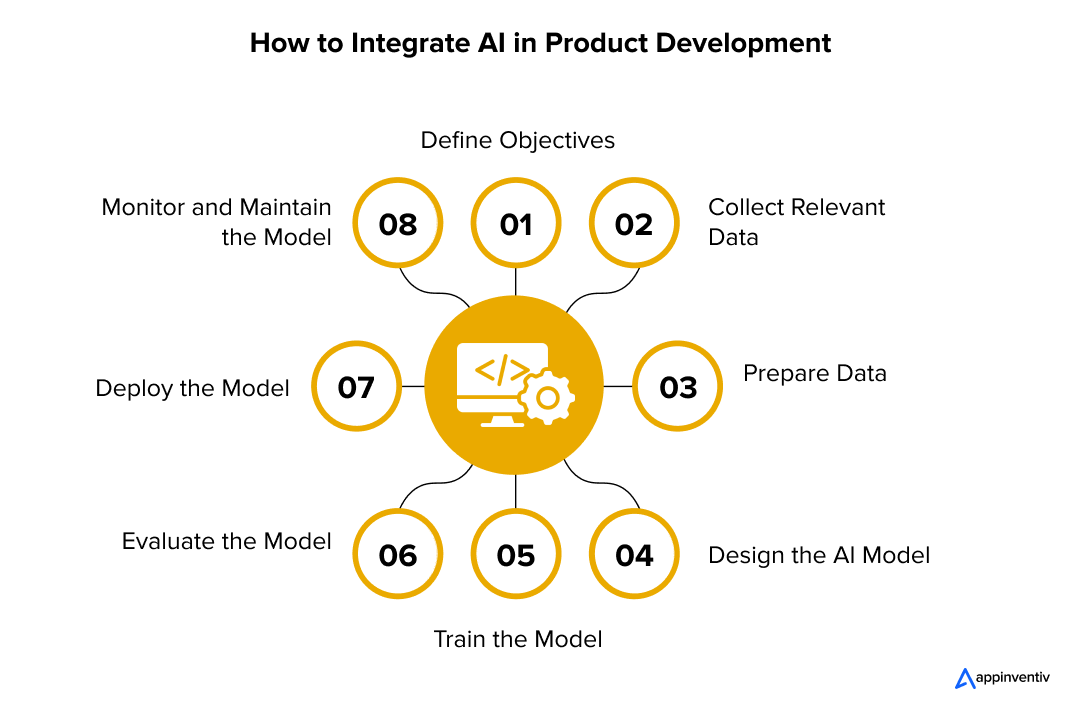
Define Objectives
The AI integration in product development starts with establishing clear goals by identifying specific problems your product will address and the outcomes it is expected to achieve. This phase aligns business strategies with technological possibilities and essential regulatory compliances.
Collect Relevant Data
The next step is to collect high-quality and relevant data from diverse sources essential to training your AI model. This step involves identifying the data needed and ensuring compliance with data protection regulations. Remember, the volume and quality of data directly influence the efficiency and accuracy of an AI-driven product. In contrast, irrelevant and inadequate data sets can limit the AI system’s ability to deliver accurate results.
Prepare Data
After collecting the data, you should clean, label, and preprocess it to eliminate inconsistencies and improve its usability. This phase ensures the data is ready for model training and aligns with the objectives.
Design the AI Model
AI developers use the appropriate algorithms and frameworks based on the pre-defined problem in this phase. This phase includes creating the architecture of the AI model and defining its parameters for optimal performance.
Train the Model
Here comes the most integral stage of the AI integration lifecycle in product development. At this stage, you need to feed the prepared data into the AI model and fine-tune it by adjusting parameters. This iterative process helps the model learn patterns and make accurate predictions.
Evaluate the Model
Before you deploy the trained AI model to the intended infrastructure, you must test its performance using validation datasets to ensure it meets predefined success metrics. This step identifies potential gaps and areas for improvement.
Deploy the Model
After the iterative evaluation, you can integrate the AI model into the product infrastructure, ensuring seamless integration with existing systems. This phase also includes setting up APIs or interfaces for user interaction.
Monitor and Maintain the Model
Continuously monitor the model’s performance in real-world scenarios to address errors, glitches, or inaccuracies as they arise. Regular updates, maintenance, and retraining AI models ensure the AI-powered product stays effective over time.
How Does AI Work in Product Development?
AI in product development transforms traditional processes by automating complex tasks and enhancing decision-making. Here is a step-by-step breakdown of how it works:
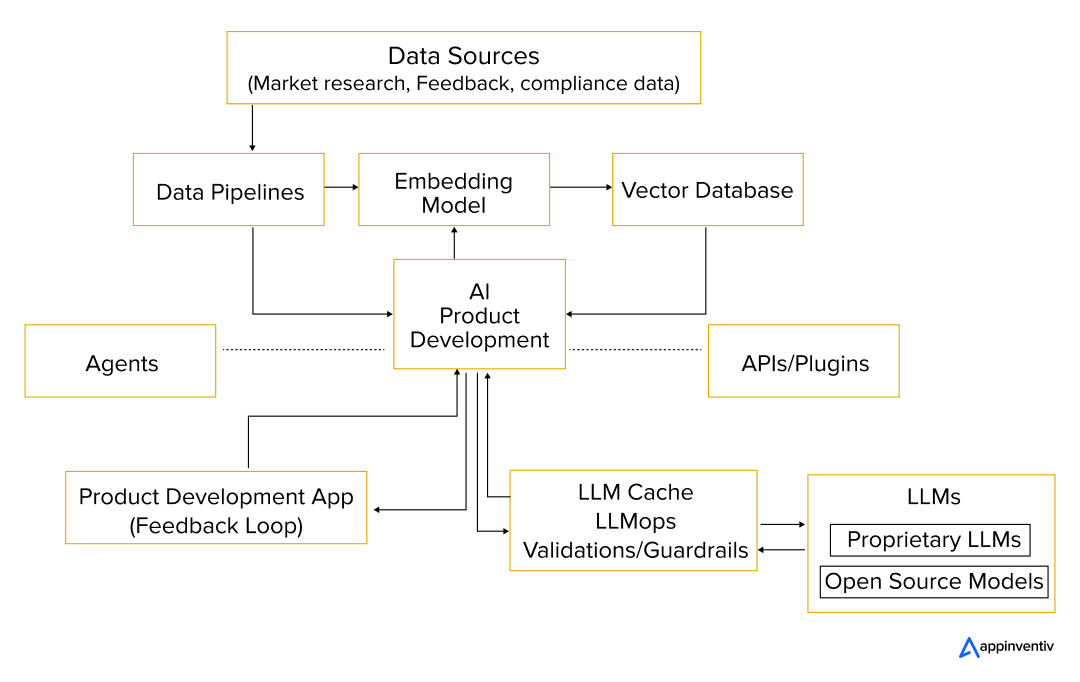
Data Sources: AI-driven product development counts on various rich and comprehensive data sources to shape its strategies, including market research, customer feedback, performance metrics, financial data, and regulatory standards. This ensures a thorough understanding of user needs and market dynamics.
Data Processing: Collected data flows through pipelines for cleaning and structuring, making it analysis-ready.
Embedding Model: Tools like OpenAI and Google models convert text into vectors (numerical data) for AI understanding.
Vector Database: These vectors are stored in databases like Pinecone and PGvector, enabling efficient searches and retrievals.
APIs and Plugins: APIs (e.g., Zapier, Wolfram) connect data and tools, seamlessly integrating additional functionalities and external platforms.
Orchestration Layer: Platforms like ZBrain manage workflows, retrieve context from databases, call APIs, and generate prompts for language models, coordinating every component effectively.
Query Execution: The process begins with user queries on product design, market fit, or strategy submitted via a development app.
LLM Processing: The orchestration layer retrieves relevant data and sends it to an LLM for query-specific insights, choosing LLM tailored to query complexity.
Output Generation: LLMs deliver actionable insights, such as design recommendations or market analyses, to the user.
Product Development App: Insights are presented via a specialized app, simplifying access for development teams.
Feedback Loop: User feedback refines AI outputs, enhancing accuracy and relevance over time.
Agents: AI agents tackle complex tasks, leveraging memory, strategic planning, and self-reflection to adapt and learn post-deployment.
LLM Cache: Tools like GPTCache and Redis store frequently used data, improving system response time.
Logging and LLMOps: Throughout this process, tools like Weights & Biases and MLflow track performance, ensuring operational efficiency and enabling continuous improvement.
Validation: Tools like Guardrails and Rebuff validate LLM outputs, ensuring their accuracy and reliability before use.
LLM APIs and Hosting: Platforms like AWS and OpenAI host applications and execute tasks, with developers choosing APIs and hosting tailored to project needs.
The Role of Generative AI for Product Development
Generative AI in product development revolutionizes the process by automating complex tasks, driving innovation, and streamlining business operations for different industries. This technology leverages advanced algorithms to generate new and realistic outputs, such as text, images, designs, or software code, based on patterns in its training data. Here are the key contributions of Gen AI in Product Development
Improving idea and design generation
One of the most important aspects of Gen AI making waves is idea and design generation. The technology helps design products that can efficiently meet operational requirements and suit changing consumer needs,
Rapid prototyping and iteration
Generative AI facilitates rapid prototyping and iteration. It allows companies to create software, apps, and even physical products with unmatched excellence that drive growth and efficiency in the competitive age.
Mitigating Risks
Generative AI makes it easy to detect risks early in the development cycle, allowing developers to resolve them at the prototype stage and avoid costly errors, fraud, or process inefficiencies.
Personalizing Product Experiences
Gen AI in product development helps personalize users’ experiences. By analyzing the sheer volume of user data, Gen AI algorithms evaluate individual preferences and tailor products to meet their unique demands.
How is AI Transforming Product Development?
The AI product development life cycle comprises several stages to guarantee outcome-oriented delivery. Artificial intelligence in the development lifecycle can accelerate the release of new services and products onto the market. Let’s examine the potential effects of the various components of the AI product development life cycle.
Project Management
AI can play a crucial role in project management during product development. It can help with scheduling, risk assessment, and resource allocation. AI for product development tools can forecast possible bottlenecks, estimate project timeframes, and recommend the best resource allocation. This aids in decision-making and guarantees resource efficiency.
Product Design
AI for product design can help automate tedious design tasks and provide insightful recommendations. AI-powered tools can provide interactive prototypes and suggest color schemes. They can also offer layout possibilities depending on user preferences. Using data-driven design choices boosts the design iteration process and improves user experience.
Product Security
AI protects products from security risks by identifying and averting them. Artificial intelligence algorithms can examine network traffic, user behavior, and system records. They can find patterns that could be signs of unauthorized access attempts or AI cyberattacks. AI can also facilitate adaptive security mechanisms, strengthening and updating the product’s security defenses with time.
Quality Assurance
AI is a useful tool for quality assurance that may be used to find flaws, correct them, and raise the standard of products. Automated testing can be carried out using AI tools for product development. This can guarantee thorough coverage and quicker testing cycles. AI can also analyze usage data and customer reviews to find error patterns, allowing for faster bug repair.
Product Architecture Design
AI can help define a product’s architecture and optimize its design in its early phases of development. AI-powered algorithms can assess architecture choices by considering cost, performance, and scalability. This helps develop a solid and effective product base. In addition, AI-powered tools help create UI/UX prototypes following stakeholder-defined design requirements.
Intelligent Coding
Developers benefit from an AI-powered code editor with sophisticated features that can suggest code completions and rearrange code for better structure. Developers may solve common mistakes, improvements, and bugs using generative AI for coding. This can free up more time for more creative problem-solving. A survey shows that 70% of respondents believe AI coding tools will give them an advantage at work and result in better code.
How to Build an AI-Powered Product?
Considering the growing significance of AI’s power in product development, do you wish to explore how an AI-powered product is built?
To construct an AI-backed product, companies must assemble a team knowledgeable in software development and artificial intelligence to properly integrate AI tools for product development. This entails figuring out what expertise and understanding are required to work with AI and ensuring that team members have it.
Let’s take a look at all the steps that accomplish this process:
Starting with Market Research
Start with a thorough market research approach to find a distinctive product concept that satisfies unfulfilled market demands. Develop a comprehensive grasp of your niche using analytical techniques like SWOT analysis. This will help you develop ideas for products that are both creative and precisely in line with what the market needs. Closely examine your competitors to gather information about how AI is used in their products.
Identifying Ideal AI Skills and Talent
There is a talent gap because of the rapid rise of AI, which has outpaced businesses’ capacity to adjust. Finding the appropriate talent is essential to building an AI-powered product development team that will close this gap. Seek experts like data scientists, machine learning engineers, computer vision specialists, NLP specialists, and AI product managers. These individuals will be crucial to creating and applying successful AI technologies.
Encouraging Cross-functional Collaboration
Fluency in technical know-how alone is insufficient. It is also essential to promote cross-functional collaboration. This can be accomplished by integrating AI specialists into product teams and facilitating knowledge exchange and continuous learning. By doing this, everyone on your team will understand how AI fits into the product development process, resulting in maximum efficiency.
Cultivating AI-powered Culture
Developing an AI-driven culture is crucial. This consists of supporting experimentation and iteration. It even involves advocating for data-driven decision-making and supporting AI ethics. This guarantees the responsible application of AI and cultivates an innovative culture. Such an AI-powered culture keeps your company ahead of the always-changing AI landscape.
By broadly navigating these steps and partnering with a leading custom AI development company like Appinventiv, you can empower your product and product development pipeline in manifold ways.
Decoding Key Use Cases of AI in Product Development
Gaining some knowledge about this industry is necessary before comprehending how AI is used in product development. To understand better, let’s review some significant AI in product development use cases.
Use Case 1: Predictive Maintenance
AI product strategy can predict product or equipment faults before they happen. Thus, predictive maintenance reduces downtime and increases asset longevity. AI can use usage patterns, previous performance data, and sensor data to forecast when maintenance or repairs are likely necessary.
Machine learning (ML) algorithms detect early warning indicators of possible problems. This enables prompt action and lowers the possibility of unexpected malfunctions. Predictive maintenance increases operational effectiveness, reduces costs, optimizes maintenance schedules, and improves the equipment or product’s overall performance.
Real Example: BMW
German automotive company BMW analyzes data from its production lines and forecasts when maintenance is required using AI-powered technologies. The hugely popular BMW brand has increased production efficiency and decreased downtime by using predictive maintenance.
Use Case 2: Regulatory Compliance
By continuously evaluating legislative requirements and industry standards, AI automates the monitoring and enforcement of regulatory compliance. AI systems can ensure that processes and goods meet these standards. AI product development can spot compliance problems and keep track of regulatory changes.
AI creates reports using machine learning and natural language processing. This makes complicated regulatory compliance easier to audit and manage. By being proactive, you can lower non-compliance risk and maintain good status with regulatory organizations.
Real Example: Health-e app
The best example of the deployment of AI in healthcare product development is the Health-e app. Appinventive assisted the company in developing an AI-based concentrated platform that integrates traditional medical data from appointments, laboratory results, imaging, and clinical data with wellness information collected from personal sensors. This includes data on sleep patterns, physical activity, weight, blood pressure, and other pertinent health metrics.
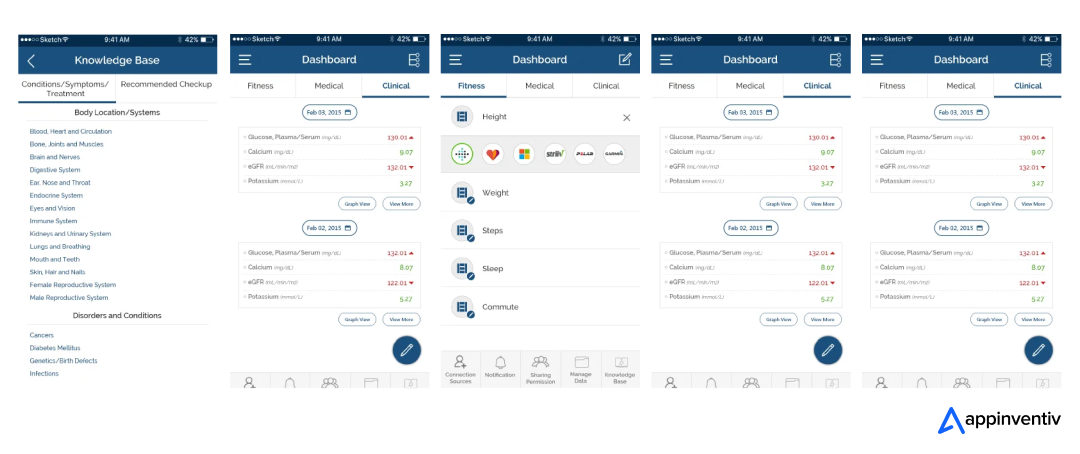
Use Case 3: Graphic Designing
Artificial intelligence streamlines the design process through automated design variations in product development. AI systems produce a range of design ideas based on user data, design trends, and customer input. This enables designers to swiftly select the most successful design by allowing them to investigate a greater range of options.
AI tools for product development maximize functionality and improve immersion. They help you create high-fidelity graphic designs and wireframes customized to user preferences and specifications. AI models improve designs based on user feedback through iterative feedback loops. This guarantees the development of user-centric interfaces that improve the overall user experience.
Real Example: FigJam AI
Figma introduced FigJam AI, a collaborative whiteboard application that uses AI to help teams generate ideas. It facilitates the generation of concepts and ideas, encouraging collaboration between product development teams or UX/UI designers. It can be used to make a template for a whiteboard interview, a shadowing session, or a design review session for a new feature.
Use Case 4: Identifying Customer Needs
Artificial intelligence in product development can determine customer needs. This is easily done by examining enormous amounts of data to find common patterns and preferences among target audiences. AI uses machine learning algorithms to create creative scenarios that capture consumer needs and pain spots. This makes it easier for product development teams to grasp what they need to build.
AI product strategy makes the process of writing customer profiles more efficient. Teams can concentrate on developing features that directly solve the main issues that their target consumers have. This will ultimately result in more successful product development strategies.
Real Example: Mudra
Mudra deploys AI to identify customers’ needs and gets an AI-based budget management app developed by Appinventiv. The application is a chatbot-centric budget management solution that monitors users’ expenses and informs them when their budget gets out of hand.
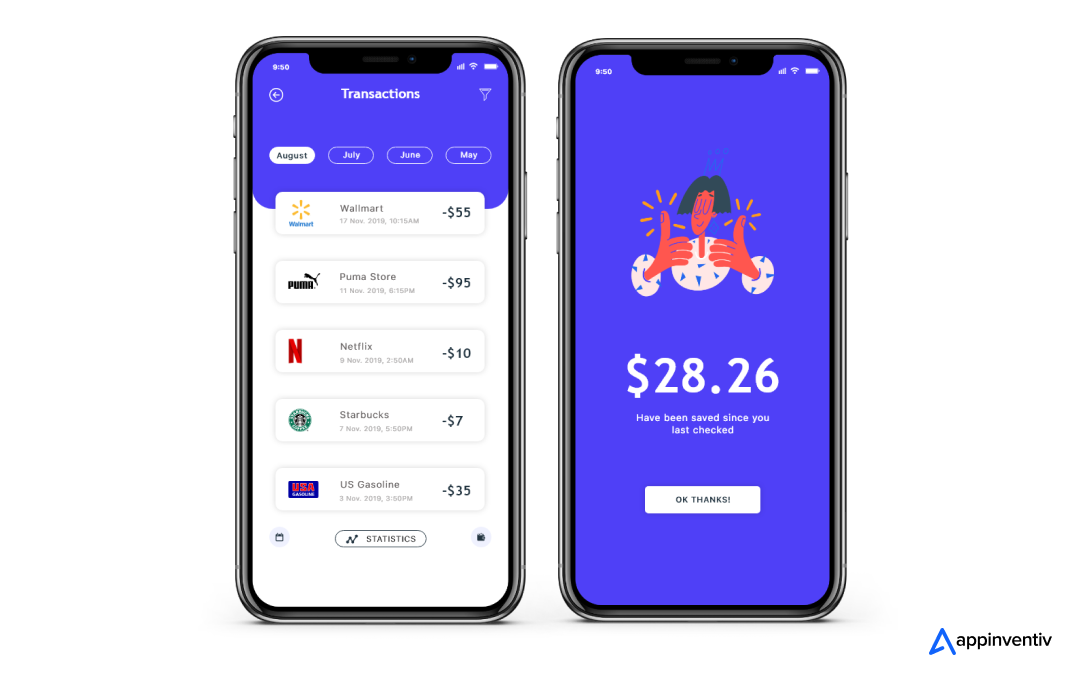
Results: After six months of dedicated design and development, the team successfully created a chatbot application ready for launch in over 12 countries worldwide. Equipped with interactive features, the application is set to become an engagement magnet and a transformative force in the Fintech industry.
Use Case 5: Customer Journey Mapping
AI-powered product development can greatly improve customer journey mapping by analyzing data from many touchpoints. AI can create detailed profiles of customer experiences with a brand or product. Using sophisticated ML algorithms, AI can also monitor and evaluate user preferences, habits, and interactions from initial contact through the post-purchase phase.
This helps companies see the full customer experience, pinpoint issues, and comprehend how customers interact with the product. By leveraging this information, you can better fulfill your customers’ demands. You can boost customer satisfaction and loyalty by customizing your marketing strategies, enhancing customer experiences, and optimizing touchpoints.
Real Example: deRamon Plastic Surgery Institute
Utilizing Google Analytics’ Users Flow function, deRamon Plastic Surgery Institute gathered information about how users engage with its website. The gallery and certain service pages greatly interested visitors by examining common routes and customer behaviors. They supplied the crucial information its customers sought and enhanced the conversion rates on these pages. The site also included educational content, updated images, and customer testimonials.
Use Case 6: SaaS Platform/Application
AI integration in the SaaS products helps transform businesses’ operations, streamlining workflows and enhancing user experience. AI-powered tools in SaaS applications provide advanced features like personalized recommendations, automated processes, and predictive analytics, which can dramatically improve customer satisfaction and operational effectiveness. AI also enables better data-driven decision-making, improving the quality of service while adapting quickly to market demands and user preferences.
Real Example: Ility
Appinventiv developed ility — a SaaS-based white-label platform for the real estate industry. The platform enables property owners to manage their multi-property portfolios seamlessly, unlocking new growth opportunities and enhancing user experience.
The results?
- 40% higher occupancy
- 2% increased landlord ROI
- Enhanced operational efficiency
- Reduced Infrastructure costs
- Improved customer satisfaction
Cost of AI in Product Development
When assessing the cost of AI in product development, it’s critical to consider every element that contributes to the total financial outlay. Generally, a mid-size project can range from $50,000 to $500,000. The exact cost is determined by the region, industry, degree of personalization needed and other specific project criteria.
Let’s take a look!
Data Collection
There are various methods for gathering data, and the decision is based on the project’s magnitude. For small-scale datasets, the costs can range from a few hundred dollars to several thousand dollars, depending on the extent and specialty of the dataset. Should further sophisticated data collection tools be needed, the cost may exceed several hundred thousand dollars. Ideally, data acquisition cost you around $10,000 – $50,000.
Data Preprocessing
Preparing data for training requires cleaning, classifying, and formatting, which can be costly. Data analysts are frequently needed to help with data preprocessing. Depending on the source and location, the typical yearly cost for hiring a data analyst might be from $60,000 to $120,000. The services needed for a project typically last one to four months, so the price range can be between $10,000 and over $40,000.
Hardware
The development of AI projects requires powerful hardware. Some examples are GPUs, TPUs, and NLP systems. Hardware can range widely in cost; a top-tier GPU can set you back over $10,000. Renting GPUs and TPUs is typically a more prudent choice than purchasing them. Generally speaking, a project requires about 1000 for training and 10 for operation.
Cloud Services
Cloud-based services like GCP and AWS are suitable for AI product development because of their scalability and flexibility. While training:
- Capable machines can cost up to $30,000 to $40,000 per month
- A fairly simple GPU server on AWS can cost roughly $3,000 to $4,000,000.
- A simple GPU server on TensorDock platforms costs $400 per month.
- Meanwhile, a server for training purposes costs approximately $15 to $50 per hour.
Algorithm Design
Hiring qualified AI algorithm developers is crucial to developing artificial intelligence technologies. Experts with the necessary skills can create custom algorithms or modify current ones to meet requirements. The cost of this design varies on the complexity and length of the project, from $20,000 to more than $100,000.
Training AI Models
Training models requires a lot of resources. Depending on the volume of data and model complexity, the cost of this operation can range from $10,000 to above $100,000.
AI Frameworks
AI frameworks like TensorFlow and PyTorch can be implemented for free. However, the time and knowledge required for integration and configuration may incur additional expenses.
Deployment
Deploying AI technologies into current systems varies greatly based on your company’s needs. An experienced developer can spend two to three hours integrating a basic text generation capability. A specialized model development project can cost up to a million dollars and take six to twelve months to complete.
Support and Maintenance
A successful AI model works properly after deployment with continuous support and maintenance. This task can cost you $5,000–$20,000 a year.
Security
Adhering to data protection requirements and implementing strong security measures are essential. These measures can raise your budget by $5,000 to $15,000 or more.
Training
Sometimes, staff members are required to be trained. The expense of training to operate and maintain AI systems effectively can be extra, ranging from $2,000 to $10,000 or more.
How to Integrate AI in an Existing Product
Integrating AI into an existing product involves a strategic approach with 6 crucial stages. Here is a step-by-step process of AI integration into an existing system:
Identify Opportunities and Goals: Analyze your product’s workflow to pinpoint areas where AI can add value, such as automating repetitive or error-prone tasks.
Choose the Right AI Model: Either build from scratch or choose a custom AI model taht can adapt to your changing business requirements or scale as your operations grow.
Prepare Data: Collect a high volume of data and structure it effectively, ensuring it’s clean, relevant, and sufficient for training AI systems.
Start with a Pilot Project: Begin with a small-scale implementation to test feasibility, gather insights, and refine the AI features.
System Integration: Seamlessly embed AI into your existing system while ensuring maximum compatibility and minimal disruption.
Ethical Challenges Encountered in Product Development Using AI
You must navigate ethical considerations for AI in product development when creating new AI goods or services. It is critical to recognize that AI could trick or take advantage of consumers. Acknowledging these biases is essential, as is taking action to guarantee that AI technologies are inclusively and ethically developed. Some primary areas to focus on are given below.
Bias and Discrimination
Challenge: Bias and discrimination are among the most important challenges in AI product development. AI models replicate the data they are trained on. They may unintentionally reinforce biases, producing unfair and unequal results.
Solution: You must ensure that the resulting AI systems function impartially and promote fairness across all societal sectors. This requires thoroughly evaluating and purifying training data.
Data Privacy
Challenge: Data privacy is one of AI product development’s most important legal issues. Complying with data protection regulations, such as the CCPA (California Consumer Privacy Act) in the U.S. or the GDPR (General Data Protection Regulation) in the E.U..
Solution: AI systems frequently rely on enormous databases, some of which may contain private or sensitive information. Businesses need to ensure that user privacy is respected during data collection, storage, and processing.
Transparency and Explainability
Challenge: AI systems are frequently called “black boxes,” as their decision-making method is not transparent. This inability to explain might be problematic, particularly in regulated sectors like banking and healthcare.
Solution: To address transparency and explainability challenges in AI, companies can provide clear explanations of how AI systems make decisions. Regular checks and making the process understandable to users also help build trust.
Intellectual Property
Challenge: Intellectual property (IP) is a complex topic with every product development. An Al system produces ideas or products, but who owns the IP? This field of law is always changing, with different authorities adopting different strategies.
Solution: Companies leveraging AI in their product development must carefully navigate these complexities, thoroughly considering how IP rights will be managed in the context of AI-generated outcomes.
Ethical Use of AI
Challenge: Establishing ethical AI environments is a critical responsibility of product development companies. This includes laying down precise rules that prioritize ethical AI practices and steps to detect and eliminate biases.
Solution: Organizations may play a significant role in creating an ethical AI framework that benefits all parties involved. This can be done by raising awareness among the public and looking for practical solutions.
Core Benefits of AI in Product Development
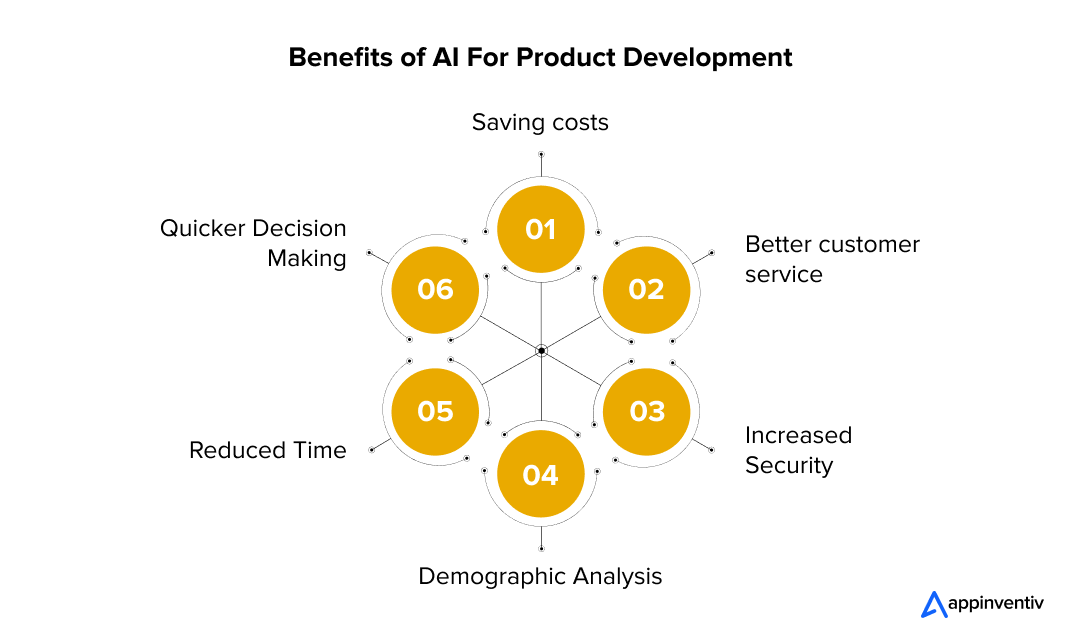
As we discuss AI product development, now is the ideal time to mention its advantages. Here is a list of the most prominent benefits of AI in product development that can help you as a business owner to make an informed decision.
Boost Productivity
Product development and AI work together to improve productivity to a higher degree. AI automates repetitive and time-consuming software product development chores, such as testing, designing prototypes, and writing code for basic modules. AI integration streamlines the design process, lowers inefficiencies, and improves teamwork among diverse groups.
Lesser Development Costs
Artificial intelligence in product development can greatly impact many different investment elements. It assists large development corporations with analysis and optimization, pinpointing areas to control future costs. Rework expenses are decreased due to higher quality and lower bug ratios. Improved requirement gathering steers the project in the right direction and lowers the possibility of risks, which saves money.
Faster Time-to-market
AI speeds up the development process because of its fundamental skills in product development automation and streamlining the development lifecycle. This makes faster time to market possible, which is now essential for standing out in a crowded market.
AI speeds up delivery and ensures high-quality goods by several methods. Mention may include code generation, automated product testing, improving project management, and streamlining deployment.
Higher Product Quality
AI technologies improve product quality by enabling more advanced testing and simulations—from simulating various scenarios to identifying any design problem. All these can be done before building actual prototypes. This guarantees that the finished product meets or exceeds your expectations by cutting down on the time and cost of multiple iterations.
Enhanced Innovation
AI for product design is a strong foundation for innovation. AI’s generative skills help to promote an innovative atmosphere by producing concepts for ground-breaking products. Prototyping in short iterations allows your development team to create and test new concepts or prototypes swiftly. By utilizing AI for product development tools, you may thus push the frontiers of product innovation.
Personalized User Experience
In the era of personalization, artificial intelligence is essential for understanding consumer preferences and designing products appropriately. AI algorithms analyze consumer data to determine unique tastes, propose customized product features, and suggest related items. This personalized experience has advantages, including brand loyalty, customer satisfaction, and repeated business.
Data-driven Decision Making
Integrating AI in the product development process facilitates intelligent and data-driven decision-making. AI and ML algorithms analyze refined data to extract insights on important project stages. AI-powered product development may foresee possible project outcomes. Some other benefits are more efficient resource allocation, mitigation of risks, and ensuring product success in the market.
Flexibility and Scalability
AI systems are scalable as they are to change with the demands of the business and adjust to different workloads. AI-powered solutions may scale up or down to meet new requirements without sacrificing efficiency when product development demands change. Because of AI’s adaptability, you can easily manage the growing production volumes and bring out various products.
Transform Your Product Development Workflow with Appinventiv’s Custom AI Services
As we conclude our discussion of AI for product development, we hope our detailed analysis will encourage you to learn more about this transformative technology.
Are you thinking about kickstarting your epic journey with AI for product development? Partnering with a professional artificial intelligence development company like Appinventiv could be your golden ticket.
We’ve teamed up with big-name brands for their product development needs, such as the Vyrb social media app, Mudra budget management app, and JobGet recruitment app. With our AI dev team’s prowess and deep knowledge of AI product strategy, you can crush it in this space without breaking a sweat.
Contact us and tap into AI’s crazy potential to supercharge your product development.
The Future of Product Development with AI and Associated Technologies
Artificial intelligence will undoubtedly play a significant role in product development in the future. It will usher in a new era of creativity, effectiveness, and accuracy. Companies that use AI to its full potential can launch products faster and deliver products that meet user satisfaction.
Take a look at some of the future trends of AI for product development that can change the industry landscape.
XAI (Explainable AI): The need for transparency in the decision-making process of increasingly sophisticated AI systems is growing. XAI aims to develop AI models that can justify their choices and actions. This will increase public confidence in AI systems, especially in delicate healthcare, finance, and law domains.
DevOps: Product development and IT operations are combined in a set of procedures called DevOps. Automating and optimizing processes through the integration of AI with DevOps Services Company can achieve faster, more effective development cycles. This will result in better products and a shorter time to market.
IoT Integration: When combined with AI, integrating the Internet of Things (IoT) across product development can become smarter and more interconnected. AI’s real-time processing and analysis of data from IoT devices can create more responsive and efficient products. This is especially crucial for wearable technology, industrial automation, and smart home technology.
NLP (Natural Language Processing): This area of artificial intelligence focuses on the interaction of computers with human language. As NLP advances, you can anticipate seeing more products that can comprehend, interpret, and produce human language. This could revolutionize user interfaces, content production, and customer service.
Edge AI: Companies can leverage Edge AI’s broad acceptance to move AI processing closer to data sources. This development will allow product development service providers to handle real-time data and improve product development responsiveness. This can be helpful, especially when latency is an important consideration.
FAQs
Q: How can AI help in product development?
A: AI will have a bigger influence on how companies develop products. By harnessing AI’s capabilities, companies may obtain a competitive edge, drive greater creativity, and produce extraordinary products that surpass customers’ expectations.
Q: How is AI used for product development?
A: With AI’s growing role in product development automation tasks, your developer team can move quickly, accurately, and with high quality between stages of product development. Artificial intelligence facilitates quicker decision-making and outcome prediction by evaluating data and producing insights. As a result, this amplifies the product development cycle, leading to better, faster results.
Q: What are the future trends of AI for product development?
A: Some of the prominent future trends that you can look forward to in the sector of AI in product development are:
- Robo-medics
- Edge AI
- XAI adoption
- 3D printing
- IoT integration
- DevOps


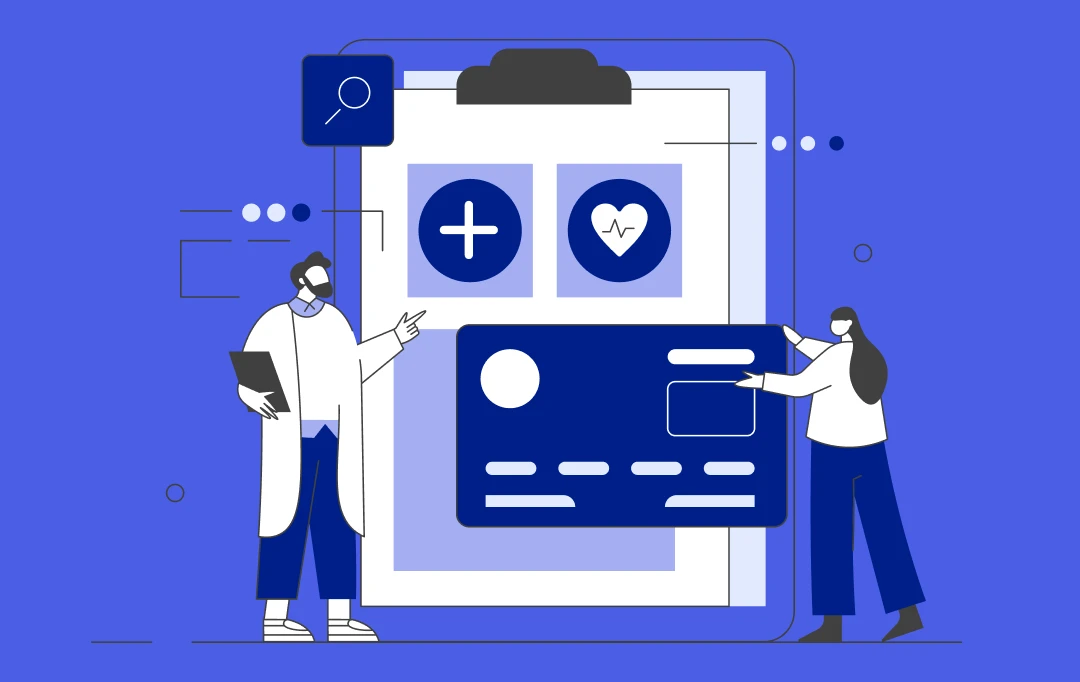
10 Ways AI is Transforming the Healthcare Sector in Australia
Key takeaways: Generative AI could add $13 billion annually to Australia’s healthcare sector by 2030. AI is already transforming operations across diagnostics, admin tasks, and patient care. Healthcare in remote areas is improving with AI-powered virtual assistants and monitoring tools. AI can help address workforce shortages by automating routine tasks and supporting clinical decisions. Major…
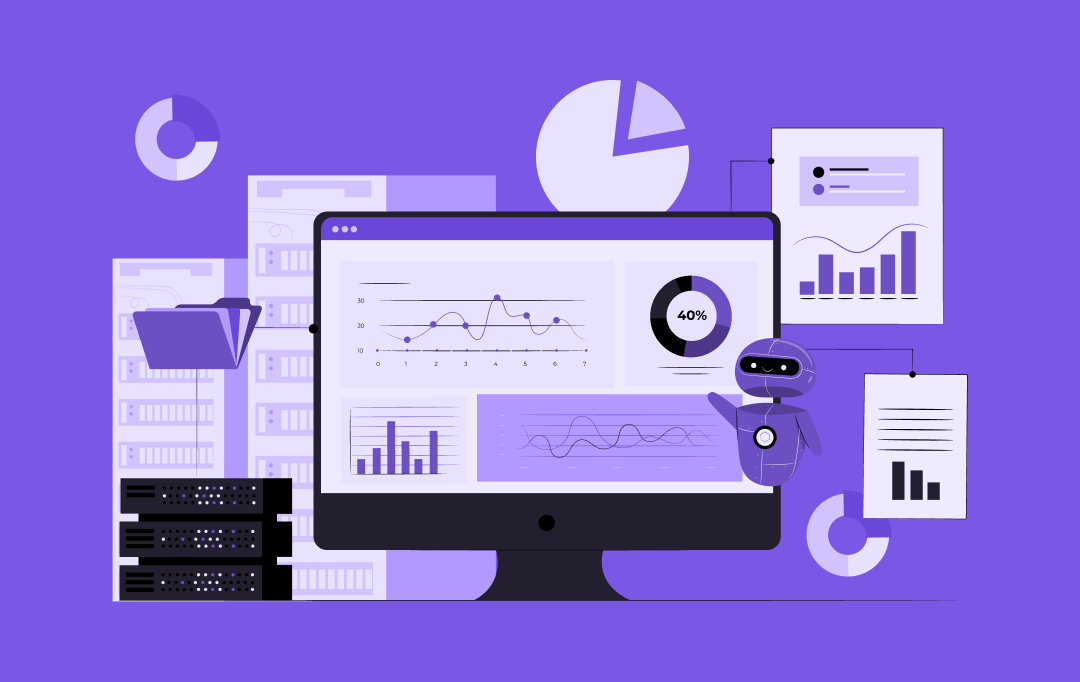
Exploring the Power of AI in Creating Dynamic & Interactive Data Visualizations
Key takeaways: AI transforms data visualization by providing automated insights, interactive dashboards, and NLP, thereby tackling revenue loss and improving data quality. Key features include predictive analytics, real-time data integration, and user-friendly visualizations, enabling faster and more informed decisions. Top 2025 tools, such as Tableau, Power BI, and Julius AI, offer NLP and real-time analytics…
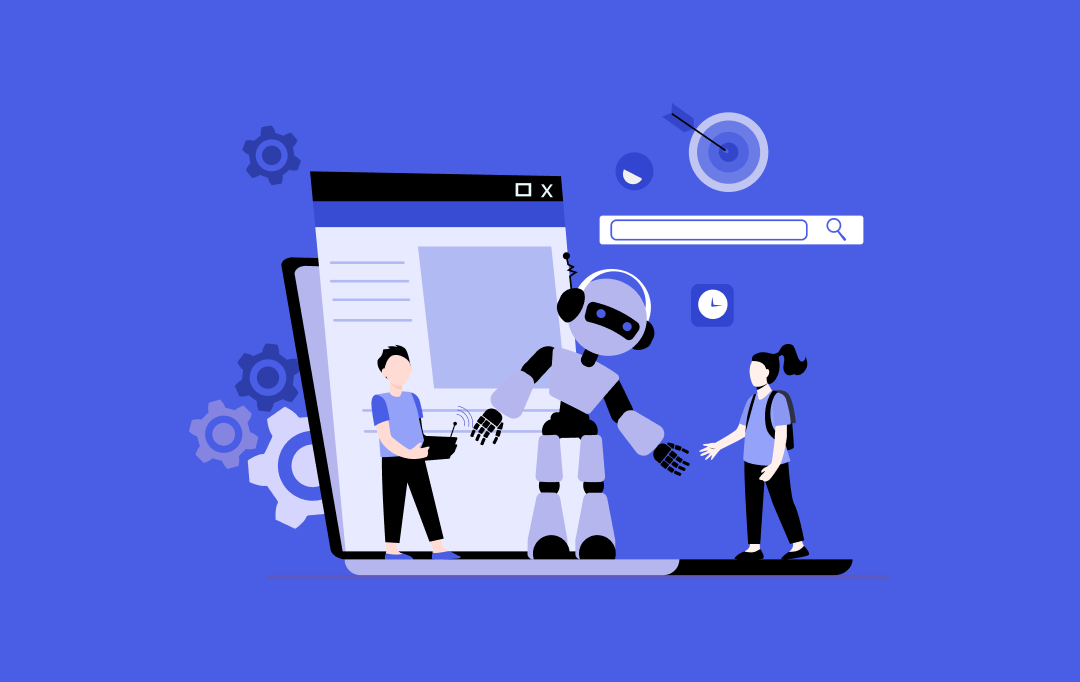
Practical Applications of AI as a Service for Your Business
Key takeaways: AIaaS enables fast, infrastructure-free AI adoption. Used across industries for automation and insights. Real-world examples show proven business impact. Pilot-first approach ensures smooth implementation. Key challenges include data, cost, and scaling. Trends include ethical AI, edge, and SME growth Imagine being able to cut down your operational costs while simultaneously improving decision-making and…









